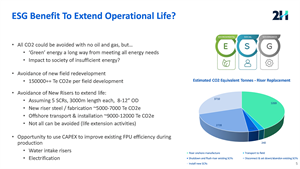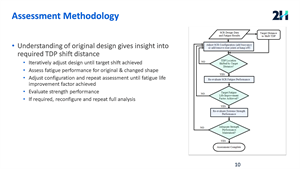Deepwater technology: No fatigue life remaining: Novel approaches for deepwater steel catenary production riser life extension to benefit ESG
After long periods of operations, many SCRs are now close to or have exceeded their certified service life. The harsh and dynamic deepwater environment has subjected these risers to long term fatigue loading accumulation, with the region around the touchdown point (TDP) where the SCR meets the seabed often being the critical area limiting any remaining fatigue life.
However, despite this challenge, Operators have a desire to continue to operate their SCRs reliably beyond their original planned service life, to maximize production and return on investment. Therefore, there is a growing interest in life extension strategies for SCRs.
ESG benefit to extend operational life
Extending the operational life of deepwater SCRs not only offers a cost-effective opportunity to increase production, but it also aligns with the principles of Environmental, Social and Governance (ESG) practices. While it is true that all CO2 emissions could be avoided by transitioning to renewable energy sources and eliminating oil and gas production, the reality is that the world is still heavily dependent on hydrocarbons to meet its energy needs.
Insufficient energy supply has a significant impact on society, and therefore, continued use of existing energy infrastructure to secure this supply becomes crucial. Extending the life of SCRs enables operators to avoid new field redevelopment, which avoids substantial additional CO2 emissions. A typical field development project can generate over 150,000 metric tons of CO2 equivalent emissions.
Further, by avoiding the need for new risers, operators also can significantly reduce the carbon footprint associated with the fabrication, transportation and installation of these risers. Assuming the installation of five typical SCRs, each with a length of 3000 meters and an outer diameter of 8–12 inches, the production of new riser steel and fabrication alone would result in approximately 5000–7000 metric tons of CO2 equivalent emissions. The offshore transport and installation of these risers would further contribute approximately 9000–12000 metric tons of CO2 equivalent emissions.
While it is not possible to completely eliminate CO2 emissions associated with life extension activities, the opportunity exists to use capital expenditure (CAPEX) elsewhere, to improve the efficiency of the existing FPU during production. This can be achieved through initiatives such as optimizing water intake risers and electrification, reducing the overall environmental impact of the operation, Fig 1.
Concepts to extend life
The challenge is how to extend life when minimal fatigue life remains at the touchdown region and the riser is beyond the certified design life.
The strategy pioneered by 2H is to apply one or more of a range of measures to relocate the touchdown point. The location of the original touchdown point (the green line in Fig. 2), with high fatigue damage accrual, must see minimal further fatigue damage accrued over the required service life extension (typically 10–20 years). The new touchdown point location (the light blue line in Fig. 2) must have minimal fatigue damage already accrued, since the SCR was originally installed so that there would be sufficient fatigue capacity remaining to accommodate the higher fatigue damage rate at this location.
There are a number of ways to relocate the touchdown point, all of which involve changing the shape of the SCR. This may be achieved through one or a combination of the following concepts:
- Relocating the floating production platform
- Changing the length of the riser, by adding or removing riser joints
- Adding buoyancy modules to the riser
However, are these concepts all suitable?
Relocating the floating production platform is an approach which is already used to extend the service life of risers in challenging fields—for example, risers operating in the Gulf of Mexico. In these cases, the platform is planned to be relocated three or more times throughout its service life, to provide the required service life, as shown in Fig. 3. However, these facilities have this capability built into the mooring system, prior to installation in the field. To retrospectively install this capability to a production platform is highly complex, costly and, given the very high construction vessel time, has emissions higher than the initial installation. It is therefore not considered a viable concept, based on practicality and ESG.
The concept of changing the length of the SCR typically requires one or two joints to be removed, to achieve the extended service life requirement. This is a complex operation, due to the need to transfer the SCR from the floating production platform to a construction vessel and then cut and re-weld the riser. These operations are, however, similar to operations that are undertaken offshore to inspect and maintain SCRs, so they involve proven offshore operations. Indeed, wherever the joint removal operation can be conducted alongside regular inspection operations, this may minimize additional construction vessel time. Even with the use of a construction vessel, good ESG benefit comes from this concept compared to a full field development, but given the complex operations involved, other concepts may be preferred.
The final concept is to add buoyancy modules (Fig. 4), and this is the preferred concept from a cost, risk and ESG standpoint. This approach utilizes existing technology to retrofit buoyancy modules to a subsea riser, using an ROV. This concept also minimizes emissions, as the operations require a much smaller vessel, compared to the other concepts. However, as installing buoyancy modules subsea with an ROV takes time, this can be a time-consuming operation, and installing high numbers of buoyancy modules erodes the ESG benefit. Typically, 10–20 buoyancy modules are required per riser to achieve the required service life extension and therefore the ESG benefit is high.
Assessment approach
An iterative process is utilised to establish the optimal solution, which achieves the service life extension required and optimises the cost and ESG benefits. The approach starts by considering if the benefits can be achieved with addition of buoyancy modules to maximise the ESG benefit. However, this approach also considers the removal of joints, if too many additional buoyancy modules are required.
The assessment process is as shown in Fig. 5 and involves:
- Identifying the number of extra buoyancy modules and removed riser joints needed to shift the TDP location the required amount,
- confirming if the fatigue requirements and strength requirements of the riser for extended service life are met,
- estimating the cost and emissions and
- Iterating until an acceptable or optimized solution is achieved.
Conclusions
A range of approaches to extend service live of SCRs are established. The extension of operational life for deepwater SCRs offered through these approaches offer significant benefits in terms of increased production, cost-effectiveness and alignment with ESG principles. By avoiding new field redevelopment and the need for new risers, operators can remove the carbon footprint associated with new oil and gas project development, and capital expenditure can be used to improve the efficiency of existing infrastructure, further reducing the environmental impact. Of these options, the addition of buoyancy is the most favourable, but to achieve adequate service life, the removal of riser of joints may also be required, limiting the overall ESG benefit.
About the author
Alex Rimmer is director of 2H Offshore Engineering and based in their London office. As well as being jointly responsible for all of 2H’s European offices, he is currently responsible for 2H's UK floating wind and decarbonization activities. Alex has nearly 20 years of experience in engineering of subsea equipment, particularly in the design of deepwater riser systems involved in the production of oil and gas, including SCRs. He has been involved in engineering these for some of the most challenging offshore oil and gas developments. Although still providing consultancy in this area, over the last five years, he has been responsible for 2H’s activities in renewable and decarbonization technologies and is applying his engineering expertise to support the energy transition.








